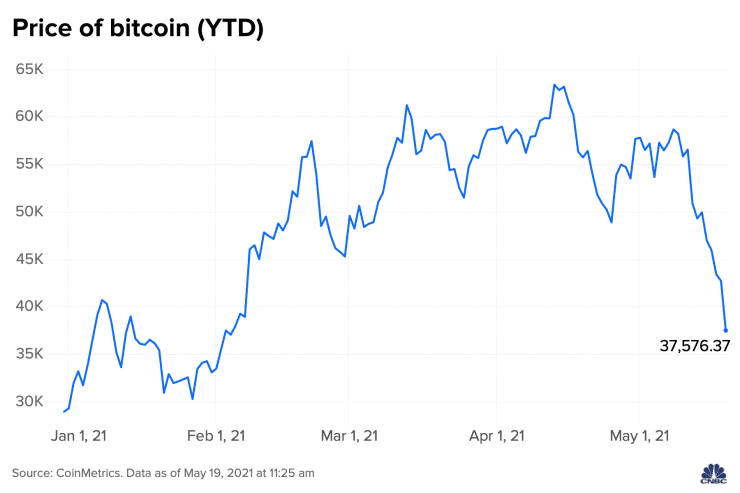
Omar Marques | SOPA Images | LightRocket | Getty Images
So you want to play in crypto and become a millionaire overnight? Brace yourself for more days like Wednesday.
Bitcoin plunged as much as 30% to about $30,000, according to Coin Metrics. Ether dropped more than 40% in less than 24 hours, breaking below $2,000 at one point. Both gained back substantial ground by the end of the day.
But this is par for the course in the world of trading cryptocurrencies. Huge run-ups and equally drastic falls. Over and over.
“Massive retracements are always scary, but seasoned investors tend to see them as buying opportunities,” said Mati Greenspan, portfolio manager and founder of Quantum Economics.
Both crypto and market experts tell CNBC that this is the new normal of investing, and traders should just get used to it.
Value and volatility
Bitcoin’s volatility has to do with a lot of things.
On Wednesday, for example, news of China cracking down on banks completing crypto transactions, plus the tailwinds of Tesla’s decision to no longer accept bitcoin as a form of payment, certainly helped drive the carnage among digital currencies. The overall crypto market was also probably due for a correction after weeks of tweet-inspired record climbs, courtesy of Elon Musk.
But volatility is also the price that bitcoin investors pay for its limited supply and its lack of a central bank to control that supply — precisely the features proponents say give it value.
Part of what makes bitcoin valuable is the fact that it is scarce. There are 18.7 million bitcoin in circulation, which is nearing its maximum threshold of 21 million.
New bitcoin are created as a reward for miners, who contribute their computing power to verifying transactions across the decentralized network. Over time, the size of these rewards decreases, so each new completed block earns miners less than it used to.
As a result, the supply of bitcoin is perfectly inelastic. “A rise in demand cannot result in the increase in supply of bitcoin or increase the speed at which bitcoin is issued,” wrote Ria Bhutoria, former director of research for Fidelity Digital Assets.
Bitcoin’s value is also derived from its decentralized network. There is no central authority which has the power to intervene in the bitcoin market.
“No central bank or government can step in to support or prop up markets and artificially subdue volatility,” continued Bhutoria. “Bitcoin’s volatility is a trade-off for a distortion-free market.”
Plus, bitcoin is still very new.
″[It’s] only 13 years old and thus doesn’t have much of a trading history,” explained Peter Boockvar, chief investment officer at Bleakley Advisory Group. “While a company that went public yesterday in an IPO doesn’t have any history, a company can at least be evaluated on its business prospects, earnings and cash flow.”
Because bitcoin is still a nascent asset class, it remains in the price discovery phase. ”[It’s] the most volatile of any asset’s life cycle,” said Mike Bucella, Blocktower Capital general partner.
“Bitcoin has clearly established itself as a new form of value, but the terminal value is still undefined,” continued Bucella. “That information gap lends itself towards a momentum, or technically driven market, absent new information.”
The path to true price discovery is often fraught with seismic price swings, but Bhutoria points out that the alternative is artificial stability, which can result in distorted markets that may break down without intervention.

Get used to it
Bucella thinks that today’s trading volatility will be repeated.
“There will be many periods like we’ve seen today, where a negative news cycle has taken out technical levels (and momentum) in the price of BTC – and those are all the more exacerbated when the market participants start taking on leverage,” continued Bucella.
What happened today is pretty typical: Spot selling breaks a key level and leverage gets liquidated, creating a more dramatic sell-off than the market would otherwise indicate. Bucella says it has been the same pattern, time and again, over the last decade, and he thinks it will remain in place until we achieve a mature level of adoption.
Ultimately, “high-risk, high-reward” does tend to be the rule of investing, and it is especially true of bitcoin.
“All investments carry risk, and just like stocks, crypto is subject to price swings,” said Noah Perlman, Gemini’s chief operating officer. “Bitcoin is still a young asset class, but it’s one of the best performing of the last decade.”
Playing the long game is crucial. “As with any market, crypto investors with a longer timeframe and diversified portfolio will see more consistent results,” explained Greenspan.
Bitcoin’s volatility also has a sort of “halo effect” over companies with exposure to the cryptocurrency.
Tesla, which has a $1.5 billion stake in bitcoin, fell roughly 2.5% Wednesday. Microstrategy, another company that holds a large amount of bitcoin for its corporate treasury, ended the day 6.6% lower, and Coinbase, the newly public crypto exchange which specifically warned in its S-1 that it was vulnerable to volatile moves in the price of cryptocurrencies, dropped 6%.
But to Bucella, this type of volatility is a gift that most fund managers in traditional markets would salivate over. “As a fund manager, with proper risk management, infrastructure and tooling, this level of volatility presents enormous opportunity,” said Bucella.
Whatever your risk tolerance, experts say the volatility won’t always be this bad.
Bitcoin trading is no longer dominated by retail buyers. Professional money managers and corporate America have flooded the market in the last year, and they’re still getting started. As more institutional investors adopt bitcoin, it lends newfound legitimacy to the cryptocurrency, helping to erase its reputational risk. It also creates more stability overall.
“With greater adoption of bitcoin and the development of derivatives and investment products, bitcoin’s volatility may continue to decrease, as it has historically,” noted Bhutoria.
And as longtime value investor Bill Miller pointed out in a CNBC interview earlier this year, “One of the interesting things about bitcoin is that it gets less risky the higher it goes.”

